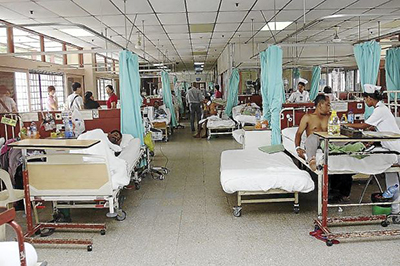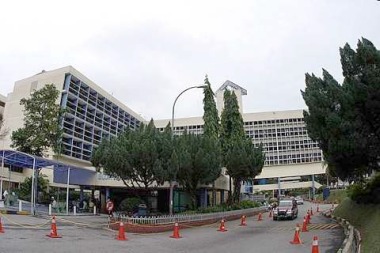
Source: thestar.com.my
Creative innovation and thinking out of the box is required. Re-engineering of the work processes coupled with increase efficiency of the service delivery is ongoing to make space to decongest the public hospitals.
We need additional human capital development and more infrastructure and requirements to progress further to meet and equipments to progress further to meet the demand.
The Health Ministry (MOH) shares the public concern regarding congestion and overcrowding in government hospitals in the Klang Valley and some of the other state specialist hospitals.
The MOH statistics in 2012 indicate that 16 out of 67 specialist hospitals have beds occupancy rate (BOR) of more than 85%, an indication that the hospitals are reaching a level that may be associated with problems of congestion and overcrowding.
This is very much related to the population increase, the rapid urbanisation in various parts of Klang Valley thus contributing to the migration of people, the prevalence of some diseases especially the chronic non-communicable diseases, trauma and injuries due to various reasons, and the occurrence of dengue fever especially in the big cities.
Take for example, the prevalence of diabetes increase by almost 120% in the last 20 years, from merely 6.4% in 1986 up to about 15% in the year 2006.
Also, the increase in the number of reported dengue fever by almost 81% from 19,920 cases reported from January to November 2012 compared to 36,021 cases reported for the same period in 2013. This increase has contributed to the congestion especially in medical wards of hospitals in Klang Valley.
The number of patients admitted in government hospitals gradually increased; in 2012, a total of 2.6 million admissions were recorded and about 19 million were seen as outpatients, as compared to about 2.1 million admissions recorded in 2010 and about 17.6 million were seen as outpatients.
There is also an increase in the admission of foreign patients (110,572 foreign inpatients in 2011 compared to 95,250 in 2008), which contributed to the usage of MOH hospital beds.
By 2015, there will be a predicted 5% increase annually in the number of hospital admission. This will mean extra admissions of about 150,000 to 200,000 patients each year and will have an impact on the infrastructure capacity of current facilities.
On the other hand, the number of hospital beds has only increased by 5,767 beds from 33,211 beds in 2010 to about 38,978 beds in 2012.
The Government took measures to address the needs of curative services in Klang Valley. Since the seventh Malaysian Development Plans (1995), four new hospitals have been built in Klang Valley — Hospital Selayang (1999), Hospital Serdang (2006), Hospital Ampang (2006) and Hospital Sungai Buloh (2006) — to decongest and decentralise services in Hospital Kuala Lumpur (HKL) as well as to cater for additional demands and increase of population projected until year 2015. In the same period Hospital Putrajaya with 275 bed-capacity started its services in 2000 while the Rehabilitative Hospital started services in Cheras last year.
For Hospital Tengku Ampuan Rahimah (HTAR) Klang, facility development has been continuous where the new Ambulatory Care Complex (ACC) block in HTAR already started operations in 2002. Selected procedures previously done as inpatient procedures are now being performed on a daycare basis and this has helped reduce the need for inpatient beds.
In addition, the new Accident and Emergency Department project was completed in 2012. Currently, the new Obstetrics Complex is under construction and due for completion in 2016. This will provide an additional 364 beds for HTAR Klang.
To further address the issue of congestion in HTAR, Shah Alam Hospital is being built and expected to be complete by October 2014.
It has capacity of 300 beds, with future expansion it may go up to 500 beds. This will be able to complement the need of people in Klang Valley, particularly those in Shah Alam, and hopefully will reduce congestion in HTAR Klang.

Source: thestar.com.my
As for HKL, the ambulatory carecentre (ACC) building, which cost RM178mil, has been completed and started operations in mid of this year. On top of that, the Government had allocated RM300mil to further upgrade the facility and infrastructure in HKL and that would be inclusive of additional 240 hospital beds.
Continuous efforts have been taken by MOH to overcome the problem of overcrowding and congestion in specialist hospitals.
These include improvement in internal work processes such as patient flow; deployment of staff to service areas in need; new modalities of care such as enhancing daycare services, homecare nursing and community rehabilitation services; encouraging the use of postal services for delivery of medicine, drive-thru’ facilities, leverage on SMS technology for managing appointments; and at the same time, looking at new infrastructure development to meet demand for care.
The Women and Children’s Hospital Kuala Lumpur with a capacity of 600 beds is currently under construction and is scheduled to be completed in 2016.
MOH is very much aware of the problem of congestion and overcrowding and appreciate the concern of the public. Rest assured, continuous effort is being taken to address these issues.
This article was adapted to include additional insight from the author from the original article initially published here on the Staronline, republished with permission from the author.
